1985 FORD GRANADA ECU
[x] Cancel search: ECUPage 115 of 255
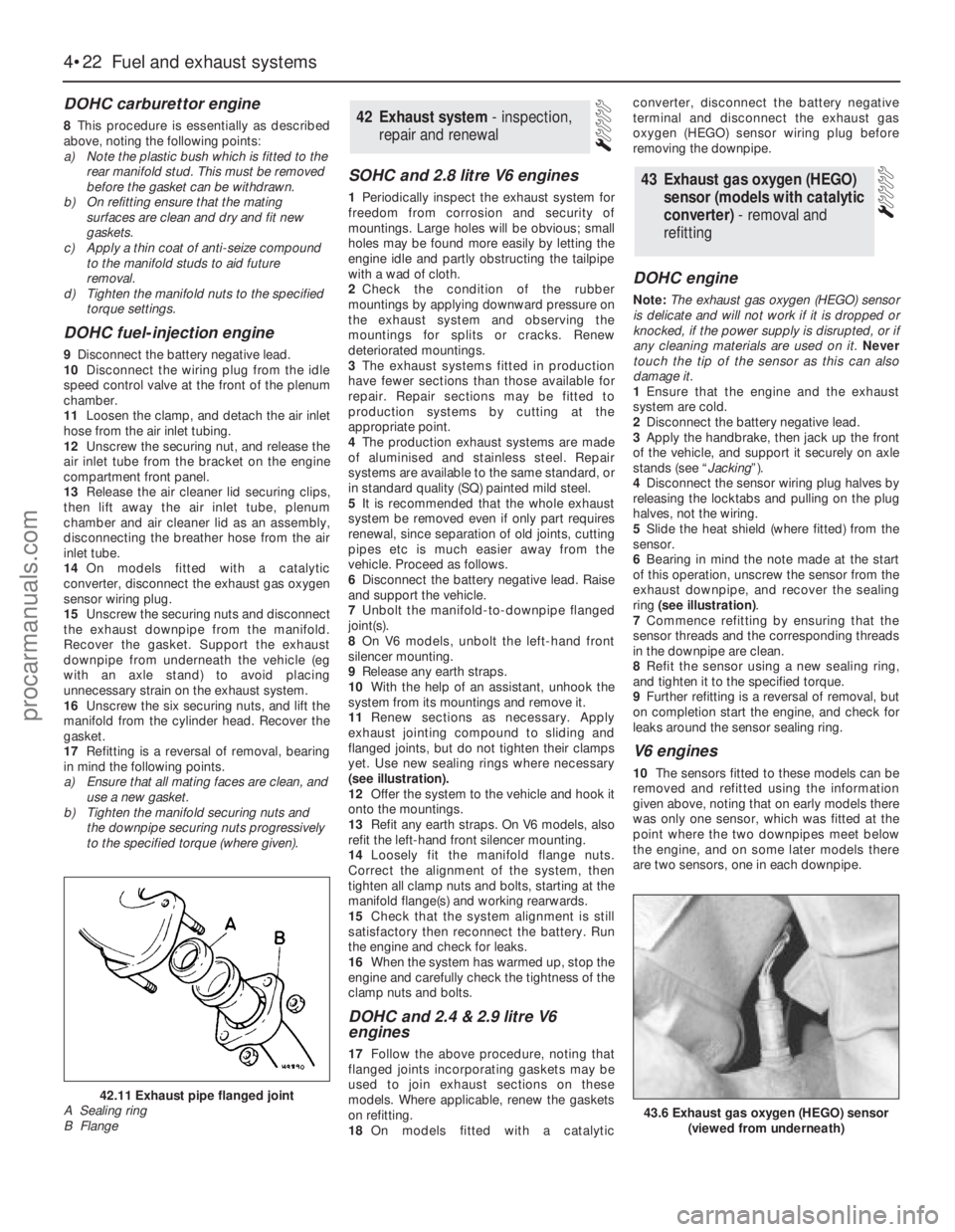
DOHC carburettor engine
8This procedure is essentially as described
above, noting the following points:
a)Note the plastic bush which is fitted to the
rear manifold stud. This must be removed
before the gasket can be withdrawn.
b)On refitting ensure that the mating
surfaces are clean and dry and fit new
gaskets.
c)Apply a thin coat of anti-seize compound
to the manifold studs to aid future
removal.
d)Tighten the manifold nuts to the specified
torque settings.
DOHC fuel-injection engine
9Disconnect the battery negative lead.
10Disconnect the wiring plug from the idle
speed control valve at the front of the plenum
chamber.
11Loosen the clamp, and detach the air inlet
hose from the air inlet tubing.
12Unscrew the securing nut, and release the
air inlet tube from the bracket on the engine
compartment front panel.
13Release the air cleaner lid securing clips,
then lift away the air inlet tube, plenum
chamber and air cleaner lid as an assembly,
disconnecting the breather hose from the air
inlet tube.
14On models fitted with a catalytic
converter, disconnect the exhaust gas oxygen
sensor wiring plug.
15Unscrew the securing nuts and disconnect
the exhaust downpipe from the manifold.
Recover the gasket. Support the exhaust
downpipe from underneath the vehicle (eg
with an axle stand) to avoid placing
unnecessary strain on the exhaust system.
16Unscrew the six securing nuts, and lift the
manifold from the cylinder head. Recover the
gasket.
17Refitting is a reversal of removal, bearing
in mind the following points.
a)Ensure that all mating faces are clean, and
use a new gasket.
b)Tighten the manifold securing nuts and
the downpipe securing nuts progressively
to the specified torque (where given).
SOHC and 2.8 litre V6 engines
1Periodically inspect the exhaust system for
freedom from corrosion and security of
mountings. Large holes will be obvious; small
holes may be found more easily by letting the
engine idle and partly obstructing the tailpipe
with a wad of cloth.
2Check the condition of the rubber
mountings by applying downward pressure on
the exhaust system and observing the
mountings for splits or cracks. Renew
deteriorated mountings.
3The exhaust systems fitted in production
have fewer sections than those available for
repair. Repair sections may be fitted to
production systems by cutting at the
appropriate point.
4The production exhaust systems are made
of aluminised and stainless steel. Repair
systems are available to the same standard, or
in standard quality (SQ) painted mild steel.
5It is recommended that the whole exhaust
system be removed even if only part requires
renewal, since separation of old joints, cutting
pipes etc is much easier away from the
vehicle. Proceed as follows.
6Disconnect the battery negative lead. Raise
and support the vehicle.
7Unbolt the manifold-to-downpipe flanged
joint(s).
8On V6 models, unbolt the left-hand front
silencer mounting.
9Release any earth straps.
10With the help of an assistant, unhook the
system from its mountings and remove it.
11Renew sections as necessary. Apply
exhaust jointing compound to sliding and
flanged joints, but do not tighten their clamps
yet. Use new sealing rings where necessary
(see illustration).
12Offer the system to the vehicle and hook it
onto the mountings.
13Refit any earth straps. On V6 models, also
refit the left-hand front silencer mounting.
14Loosely fit the manifold flange nuts.
Correct the alignment of the system, then
tighten all clamp nuts and bolts, starting at the
manifold flange(s) and working rearwards.
15Check that the system alignment is still
satisfactory then reconnect the battery. Run
the engine and check for leaks.
16When the system has warmed up, stop the
engine and carefully check the tightness of the
clamp nuts and bolts.
DOHC and 2.4 & 2.9 litre V6
engines
17Follow the above procedure, noting that
flanged joints incorporating gaskets may be
used to join exhaust sections on these
models. Where applicable, renew the gaskets
on refitting.
18On models fitted with a catalyticconverter, disconnect the battery negative
terminal and disconnect the exhaust gas
oxygen (HEGO) sensor wiring plug before
removing the downpipe.
DOHC engine
Note: The exhaust gas oxygen (HEGO) sensor
is delicate and will not work if it is dropped or
knocked, if the power supply is disrupted, or if
any cleaning materials are used on it. Never
touch the tip of the sensor as this can also
damage it.
1Ensure that the engine and the exhaust
system are cold.
2Disconnect the battery negative lead.
3Apply the handbrake, then jack up the front
of the vehicle, and support it securely on axle
stands (see “Jacking”).
4Disconnect the sensor wiring plug halves by
releasing the locktabs and pulling on the plug
halves, not the wiring.
5Slide the heat shield (where fitted) from the
sensor.
6Bearing in mind the note made at the start
of this operation, unscrew the sensor from the
exhaust downpipe, and recover the sealing
ring (see illustration).
7Commence refitting by ensuring that the
sensor threads and the corresponding threads
in the downpipe are clean.
8Refit the sensor using a new sealing ring,
and tighten it to the specified torque.
9Further refitting is a reversal of removal, but
on completion start the engine, and check for
leaks around the sensor sealing ring.
V6 engines
10The sensors fitted to these models can be
removed and refitted using the information
given above, noting that on early models there
was only one sensor, which was fitted at the
point where the two downpipes meet below
the engine, and on some later models there
are two sensors, one in each downpipe.
43Exhaust gas oxygen (HEGO)
sensor (models with catalytic
converter) - removal and
refitting
42Exhaust system - inspection,
repair and renewal
4•22Fuel and exhaust systems
43.6 Exhaust gas oxygen (HEGO) sensor
(viewed from underneath)
42.11 Exhaust pipe flanged joint
A Sealing ring
B Flange
procarmanuals.com
Page 116 of 255
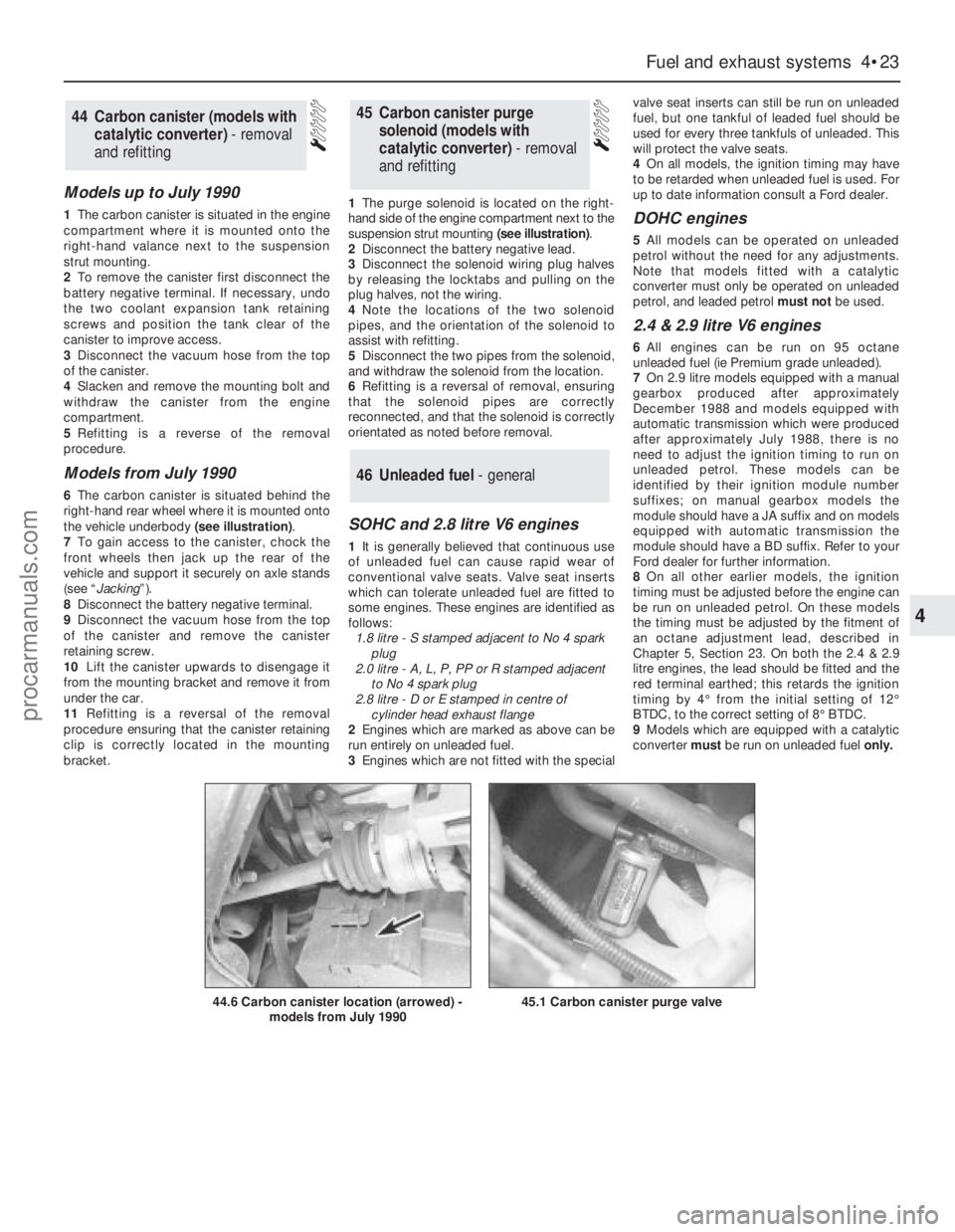
Models up to July 1990
1The carbon canister is situated in the engine
compartment where it is mounted onto the
right-hand valance next to the suspension
strut mounting.
2To remove the canister first disconnect the
battery negative terminal. If necessary, undo
the two coolant expansion tank retaining
screws and position the tank clear of the
canister to improve access.
3Disconnect the vacuum hose from the top
of the canister.
4Slacken and remove the mounting bolt and
withdraw the canister from the engine
compartment.
5Refitting is a reverse of the removal
procedure.
Models from July 1990
6The carbon canister is situated behind the
right-hand rear wheel where it is mounted onto
the vehicle underbody (see illustration).
7To gain access to the canister, chock the
front wheels then jack up the rear of the
vehicle and support it securely on axle stands
(see “Jacking”).
8Disconnect the battery negative terminal.
9Disconnect the vacuum hose from the top
of the canister and remove the canister
retaining screw.
10Lift the canister upwards to disengage it
from the mounting bracket and remove it from
under the car.
11Refitting is a reversal of the removal
procedure ensuring that the canister retaining
clip is correctly located in the mounting
bracket.1The purge solenoid is located on the right-
hand side of the engine compartment next to the
suspension strut mounting (see illustration).
2Disconnect the battery negative lead.
3Disconnect the solenoid wiring plug halves
by releasing the locktabs and pulling on the
plug halves, not the wiring.
4Note the locations of the two solenoid
pipes, and the orientation of the solenoid to
assist with refitting.
5Disconnect the two pipes from the solenoid,
and withdraw the solenoid from the location.
6Refitting is a reversal of removal, ensuring
that the solenoid pipes are correctly
reconnected, and that the solenoid is correctly
orientated as noted before removal.
SOHC and 2.8 litre V6 engines
1It is generally believed that continuous use
of unleaded fuel can cause rapid wear of
conventional valve seats. Valve seat inserts
which can tolerate unleaded fuel are fitted to
some engines. These engines are identified as
follows:
1.8 litre - S stamped adjacent to No 4 spark
plug
2.0 litre - A, L, P, PP or R stamped adjacent
to No 4 spark plug
2.8 litre - D or E stamped in centre of
cylinder head exhaust flange
2Engines which are marked as above can be
run entirely on unleaded fuel.
3Engines which are not fitted with the specialvalve seat inserts can still be run on unleaded
fuel, but one tankful of leaded fuel should be
used for every three tankfuls of unleaded. This
will protect the valve seats.
4On all models, the ignition timing may have
to be retarded when unleaded fuel is used. For
up to date information consult a Ford dealer.
DOHC engines
5All models can be operated on unleaded
petrol without the need for any adjustments.
Note that models fitted with a catalytic
converter must only be operated on unleaded
petrol, and leaded petrol must notbe used.
2.4 & 2.9 litre V6 engines
6All engines can be run on 95 octane
unleaded fuel (ie Premium grade unleaded).
7On 2.9 litre models equipped with a manual
gearbox produced after approximately
December 1988 and models equipped with
automatic transmission which were produced
after approximately July 1988, there is no
need to adjust the ignition timing to run on
unleaded petrol. These models can be
identified by their ignition module number
suffixes; on manual gearbox models the
module should have a JA suffix and on models
equipped with automatic transmission the
module should have a BD suffix. Refer to your
Ford dealer for further information.
8On all other earlier models, the ignition
timing must be adjusted before the engine can
be run on unleaded petrol. On these models
the timing must be adjusted by the fitment of
an octane adjustment lead, described in
Chapter 5, Section 23. On both the 2.4 & 2.9
litre engines, the lead should be fitted and the
red terminal earthed; this retards the ignition
timing by 4°from the initial setting of 12°
BTDC, to the correct setting of 8°BTDC.
9Models which are equipped with a catalytic
converter must be run on unleaded fuel only.
46Unleaded fuel - general
45Carbon canister purge
solenoid (models with
catalytic converter) - removal
and refitting44Carbon canister (models with
catalytic converter) - removal
and refitting
Fuel and exhaust systems 4•23
4
44.6 Carbon canister location (arrowed) -
models from July 199045.1 Carbon canister purge valve
procarmanuals.com
Page 121 of 255
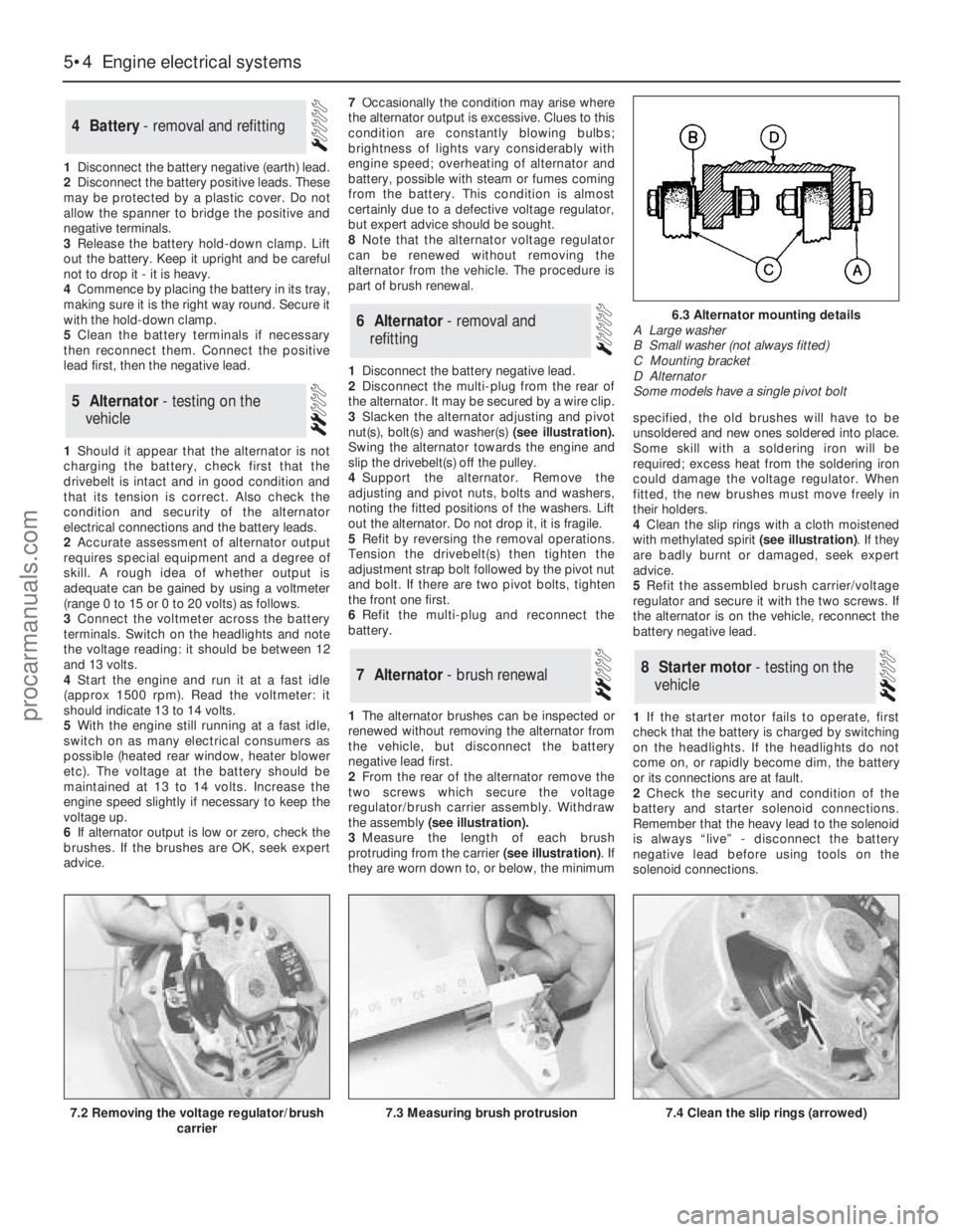
1Disconnect the battery negative (earth) lead.
2Disconnect the battery positive leads. These
may be protected by a plastic cover. Do not
allow the spanner to bridge the positive and
negative terminals.
3Release the battery hold-down clamp. Lift
out the battery. Keep it upright and be careful
not to drop it - it is heavy.
4Commence by placing the battery in its tray,
making sure it is the right way round. Secure it
with the hold-down clamp.
5Clean the battery terminals if necessary
then reconnect them. Connect the positive
lead first, then the negative lead.
1Should it appear that the alternator is not
charging the battery, check first that the
drivebelt is intact and in good condition and
that its tension is correct. Also check the
condition and security of the alternator
electrical connections and the battery leads.
2Accurate assessment of alternator output
requires special equipment and a degree of
skill. A rough idea of whether output is
adequate can be gained by using a voltmeter
(range 0 to 15 or 0 to 20 volts) as follows.
3Connect the voltmeter across the battery
terminals. Switch on the headlights and note
the voltage reading: it should be between 12
and 13 volts.
4Start the engine and run it at a fast idle
(approx 1500 rpm). Read the voltmeter: it
should indicate 13 to 14 volts.
5With the engine still running at a fast idle,
switch on as many electrical consumers as
possible (heated rear window, heater blower
etc). The voltage at the battery should be
maintained at 13 to 14 volts. Increase the
engine speed slightly if necessary to keep the
voltage up.
6If alternator output is low or zero, check the
brushes. If the brushes are OK, seek expert
advice.7Occasionally the condition may arise where
the alternator output is excessive. Clues to this
condition are constantly blowing bulbs;
brightness of lights vary considerably with
engine speed; overheating of alternator and
battery, possible with steam or fumes coming
from the battery. This condition is almost
certainly due to a defective voltage regulator,
but expert advice should be sought.
8Note that the alternator voltage regulator
can be renewed without removing the
alternator from the vehicle. The procedure is
part of brush renewal.
1Disconnect the battery negative lead.
2Disconnect the multi-plug from the rear of
the alternator. It may be secured by a wire clip.
3Slacken the alternator adjusting and pivot
nut(s), bolt(s)and washer(s)(see illustration).
Swing the alternator towards the engine and
slip the drivebelt(s) off the pulley.
4Support the alternator. Remove the
adjusting and pivot nuts, bolts and washers,
noting the fitted positions of the washers. Lift
out the alternator. Do not drop it, it is fragile.
5Refit by reversing the removal operations.
Tension the drivebelt(s) then tighten the
adjustment strap bolt followed by the pivot nut
and bolt. If there are two pivot bolts, tighten
the front one first.
6Refit the multi-plug and reconnect the
battery.
1The alternator brushes can be inspected or
renewed without removing the alternator from
the vehicle, but disconnect the battery
negative lead first.
2From the rear of the alternator remove the
two screws which secure the voltage
regulator/brush carrier assembly. Withdraw
the assembly (see illustration).
3Measure the length of each brush
protruding from the carrier (see illustration). If
they are worn down to, or below, the minimumspecified, the old brushes will have to be
unsoldered and new ones soldered into place.
Some skill with a soldering iron will be
required; excess heat from the soldering iron
could damage the voltage regulator. When
fitted, the new brushes must move freely in
their holders.
4Clean the slip rings with a cloth moistened
with methylated spirit (see illustration). If they
are badly burnt or damaged, seek expert
advice.
5Refit the assembled brush carrier/voltage
regulator and secure it with the two screws. If
the alternator is on the vehicle, reconnect the
battery negative lead.
1If the starter motor fails to operate, first
check that the battery is charged by switching
on the headlights. If the headlights do not
come on, or rapidly become dim, the battery
or its connections are at fault.
2Check the security and condition of the
battery and starter solenoid connections.
Remember that the heavy lead to the solenoid
is always “live” - disconnect the battery
negative lead before using tools on the
solenoid connections.
8Starter motor - testing on the
vehicle7Alternator - brush renewal
6Alternator - removal and
refitting
5Alternator - testing on the
vehicle
4Battery - removal and refitting
5•4Engine electrical systems
7.3 Measuring brush protrusion7.4 Clean the slip rings (arrowed)
6.3 Alternator mounting details
A Large washer
B Small washer (not always fitted)
C Mounting bracket
D Alternator
Some models have a single pivot bolt
7.2 Removing the voltage regulator/brush
carrier
procarmanuals.com
Page 122 of 255
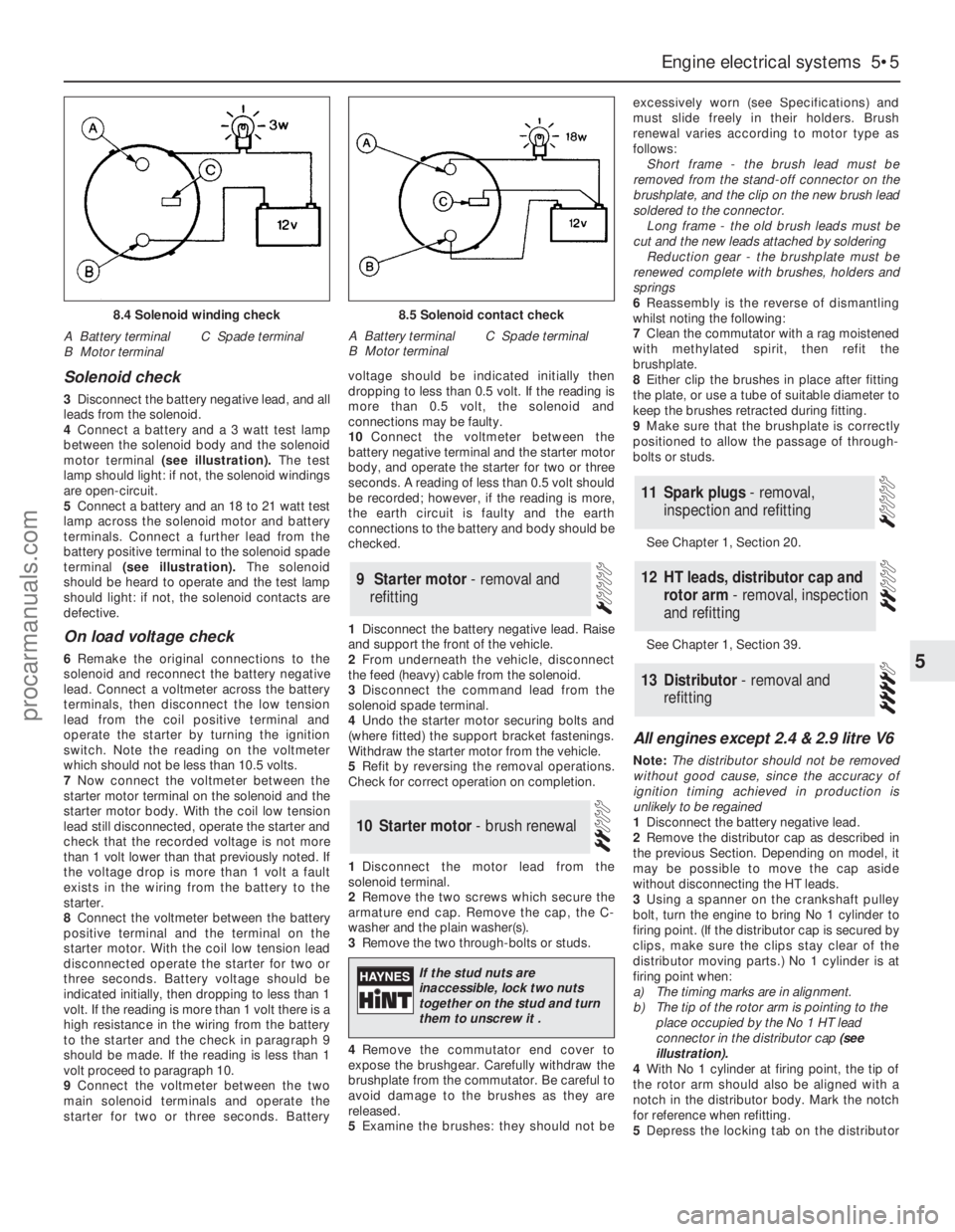
Solenoid check
3Disconnect the battery negative lead, and all
leads from the solenoid.
4Connect a battery and a 3 watt test lamp
between the solenoid body and the solenoid
motor terminal (see illustration).The test
lamp should light: if not, the solenoid windings
are open-circuit.
5Connect a battery and an 18 to 21 watt test
lamp across the solenoid motor and battery
terminals. Connect a further lead from the
battery positive terminal to the solenoid spade
terminal(see illustration).The solenoid
should be heard to operate and the test lamp
should light: if not, the solenoid contacts are
defective.
On load voltage check
6Remake the original connections to the
solenoid and reconnect the battery negative
lead. Connect a voltmeter across the battery
terminals, then disconnect the low tension
lead from the coil positive terminal and
operate the starter by turning the ignition
switch. Note the reading on the voltmeter
which should not be less than 10.5 volts.
7Now connect the voltmeter between the
starter motor terminal on the solenoid and the
starter motor body. With the coil low tension
lead still disconnected, operate the starter and
check that the recorded voltage is not more
than 1 volt lower than thatpreviously noted. If
the voltage drop is more than 1 volt a fault
exists in the wiring from the battery to the
starter.
8Connect the voltmeter between the battery
positive terminal and the terminal on the
starter motor. With the coil low tension lead
disconnected operate the starter for two or
three seconds. Battery voltage should be
indicated initially, then dropping to less than 1
volt. If the reading is more than 1 volt there is a
high resistance in the wiring from the battery
to the starter and the check in paragraph 9
should be made. If the reading is less than 1
volt proceed to paragraph 10.
9Connect the voltmeter between the two
main solenoid terminals and operate the
starter for two or three seconds. Batteryvoltage should be indicated initially then
dropping to less than 0.5 volt. If the reading is
more than 0.5 volt, the solenoid and
connections may be faulty.
10Connect the voltmeter between the
battery negative terminal and the starter motor
body, and operate the starter for two or three
seconds. A reading of less than 0.5 volt should
be recorded; however, if the reading is more,
the earth circuit is faulty and the earth
connections to the battery and body should be
checked.
1Disconnect the battery negative lead. Raise
and support the front of the vehicle.
2From underneath the vehicle, disconnect
the feed (heavy) cable from the solenoid.
3Disconnect the command lead from the
solenoid spade terminal.
4Undo the starter motor securing bolts and
(where fitted) the support bracket fastenings.
Withdraw the starter motor from the vehicle.
5Refit by reversing the removal operations.
Check for correct operation on completion.
1Disconnect the motor lead from the
solenoid terminal.
2Remove the two screws which secure the
armature end cap. Remove the cap, the C-
washer and the plain washer(s).
3Remove the two through-bolts or studs.
4Remove the commutator end cover to
expose the brushgear. Carefully withdraw the
brushplate from the commutator. Be careful to
avoid damage to the brushes as they are
released.
5Examine the brushes: they should not beexcessively worn (see Specifications) and
must slide freely in their holders. Brush
renewal varies according to motor type as
follows:
Short frame - the brush lead must be
removed from the stand-off connector on the
brushplate, and the clip on the new brush lead
soldered to the connector.
Long frame - the old brush leads must be
cut and the new leads attached by soldering
Reduction gear - the brushplate must be
renewed complete with brushes, holders and
springs
6Reassembly is the reverse of dismantling
whilst noting the following:
7Clean the commutator with a rag moistened
with methylated spirit, then refit the
brushplate.
8Either clip the brushes in place after fitting
the plate, or use a tube of suitable diameter to
keep the brushes retracted during fitting.
9Make sure that the brushplate is correctly
positioned to allow the passage of through-
bolts or studs.
See Chapter 1, Section 20.
See Chapter 1, Section 39.
All engines except 2.4 & 2.9 litre V6
Note: The distributor should not be removed
without good cause, since the accuracy of
ignition timing achieved in production is
unlikely to be regained
1Disconnect the battery negative lead.
2Remove the distributor cap as described in
the previous Section. Depending on model, it
may be possible to move the cap aside
without disconnecting the HT leads.
3Using a spanner on the crankshaft pulley
bolt, turn the engine to bring No 1 cylinder to
firing point. (If the distributor cap is secured by
clips, make sure the clips stay clear of the
distributor moving parts.) No 1 cylinder is at
firing point when:
a)The timing marks are in alignment.
b)The tip of the rotor arm is pointing to the
place occupied by the No 1 HT lead
connector in the distributor cap (see
illustration).
4With No 1 cylinder at firing point, the tip of
the rotor arm should also be aligned with a
notch in the distributor body. Mark the notch
for reference when refitting.
5Depress the locking tab on the distributor
13Distributor - removal and
refitting
12HT leads, distributor cap and
rotor arm - removal, inspection
and refitting
11Spark plugs - removal,
inspection and refitting
10Starter motor - brush renewal
9Starter motor - removal and
refitting
Engine electrical systems 5•5
5
8.4 Solenoid winding check
A Battery terminal
B Motor terminalC Spade terminal
8.5 Solenoid contact check
A Battery terminal
B Motor terminalC Spade terminal
If the stud nuts are
inaccessible, lock two nuts
together on the stud and turn
them to unscrew it .
procarmanuals.com
Page 124 of 255

12When the distributor is at the firing point,
the leading edge of one of the vanes should be
in line with the rib on the sensor (see
illustration). Turn the distributor body slightly
if necessary to achieve this.
13Refit the clamp plate and bolt. Just nip up
the bolt for the time being. Tighten it finally
after checking the timing. Also secure the
support bracket, when fitted.
14Refit the rotor arm, distributor cap and HT
leads.
15Reconnect the distributor multi-plug.
16Reconnect the battery. Run the engine
and check the ignition timing as described in
the next Section.
2.4 & 2.9 litre V6 engines
Note: The distributor should not be removed
or disturbed without good cause, since the
accuracy of timing achieved in production is
unlikely to be regained. If difficulty is
experienced in setting the timing after refitting,
or if a new distributor has been fitted, the
timing should be set by a Ford dealer using a
STAR (Self Test Automatic Readout) tester.
17Disconnect the battery negative lead.
18Disconnect the HT leads from the spark
plugs noting the correct fitted locations.
19Release the distributor cap and place it to
one side, complete with the HT leads.
20Turn the engine by means of the vibration
damper centre bolt until No 1 piston is at its
firing point (12°BTDC) (see illustration).
21If there is no mark visible, mark the rim of
the distributor body to indicate the point of
alignment of the contact end of the rotor.
22Mark the position of the distributor
mounting plate in relation to the cylinder
block.
23Disconnect the distributor wiring
connector.
24Scrape the sealant from around the
distributor clamp bolt then unscrew the bolt
and withdraw the distributor.
25Prior to refitting the distributor check that
the crankshaft is still set in the 12°BTDC
position for the No 1 piston.
26Hold the distributor over the hole so that
the mounting plinth and cylinder head marks
are aligned then align the rotor arm contact
end with the mark on the distributor rim (see
illustration).
27As the distributor is inserted, the rotor will
turn due to the meshing of the drive gears.
When the distributor is fully inserted, rotate the
distributor body until the rotor arm aligns with
mark C on the distributor rim.
28Once the rotor arm, cylinder head and
distributor alignment marks are all correctly
aligned, fit the clamp bolt and tighten it
securely.
29Refit the distributor cap then connect the
HT leads, reconnect the vacuum pipe and
wiring plug.
30Run the engine to normal operating
temperature and check the ignition timing,
bearing in mind the note made at the start of
this sub-Section.
All engines except DOHC
1Ignition timing is set very accurately in
production. It does not need to be checked or
adjusted on a routine basis. Adjustment will
only be necessary if the distributor, or an
associated component such as the timing belt,
has been disturbed.
2Before checking the timing, the following
conditions must be met:
a)The engine must be warmed up
b)On carburettor models, the vacuum pipe
must be disconnected from the manifold
and the manifold hole be plugged
c)Idle speed must be below 900 rpm
d)Any earthed “octane adjustment” wires
must be temporarily isolated
3Locate the timing marks. On SOHC engines
the timing scale is on the crankshaft pulley,
and a pointer on the timing cover must be
aligned with the appropriate mark on the
pulley (see illustration). Note that two
alternative types of pulley may be fitted (see
illustration).On V6 engines there is a single
notch on the pulley and the timing scale is on
the timing cover (see illustration).The desiredvalues are given in the Specifications.
Highlight the appropriate marks with white
paint.
4Connect a timing light (strobe) to No 1 HT
lead, following the maker’s instructions. Some
lights require additional power connections to
be made, either to the mains or to the battery.
5Run the engine at idle and shine the timing
light onto the marks. Take care not to get the
timing light leads, clothing etc tangled in the
fan blades or other moving parts. The timing
marks will appear stationary and (if the timing
is correct) in alignment.
14Ignition timing - checking
Engine electrical systems 5•7
5
13.12 Vane leading edge and sensor rib
(arrowed) are aligned at firing point13.20 Crankshaft pulley notch set to the 12°
BTDC position
14.3a Timing marks and pointer
Cast pulley shown
13.26 Rotor arm position before (1) and after (2) refitting the distributor
X = XC Notch
procarmanuals.com
Page 125 of 255
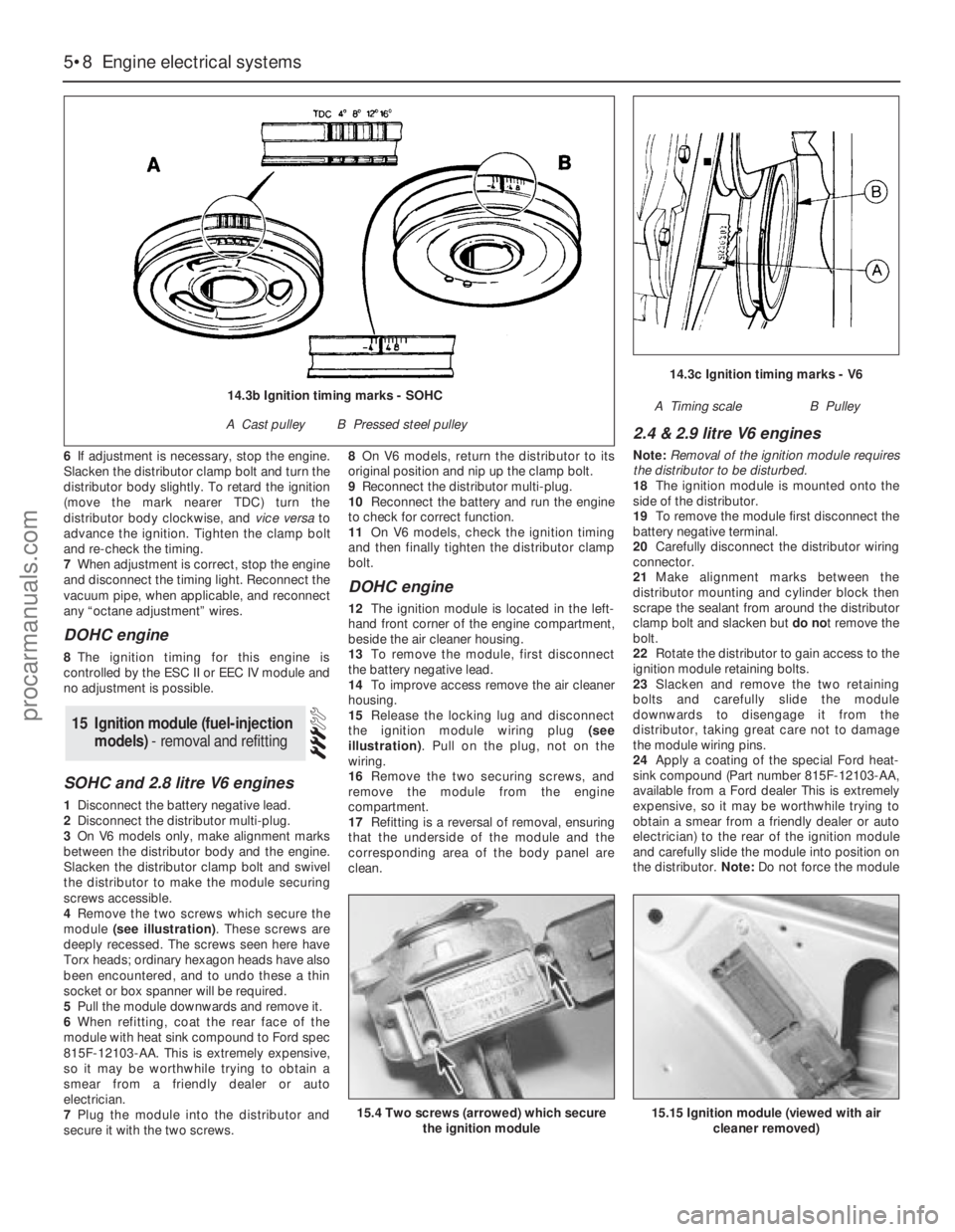
6If adjustment is necessary, stop the engine.
Slacken the distributor clamp bolt and turn the
distributor body slightly. To retard the ignition
(move the mark nearer TDC) turn the
distributor body clockwise, and vice versato
advance the ignition. Tighten the clamp bolt
and re-check the timing.
7When adjustment is correct, stop the engine
and disconnect the timing light. Reconnect the
vacuum pipe, when applicable, and reconnect
any “octane adjustment” wires.
DOHC engine
8The ignition timing for this engine is
controlled by the ESC II or EEC IV module and
no adjustment is possible.
SOHC and 2.8 litre V6 engines
1Disconnect the battery negative lead.
2Disconnect the distributor multi-plug.
3On V6 models only, make alignment marks
between the distributor body and the engine.
Slacken the distributor clamp bolt and swivel
the distributor to make the module securing
screws accessible.
4Remove the two screws which secure the
module (see illustration). These screws are
deeply recessed. The screws seen here have
Torx heads; ordinary hexagon heads have also
been encountered, and to undo these a thin
socket or box spanner will be required.
5Pull the module downwards and remove it.
6When refitting, coat the rear face of the
module with heat sink compound to Ford spec
815F-12103-AA. This is extremely expensive,
so it may be worthwhile trying to obtain a
smear from a friendly dealer or auto
electrician.
7Plug the module into the distributor and
secure it with the two screws.8On V6 models, return the distributor to its
original position and nip up the clamp bolt.
9Reconnect the distributor multi-plug.
10Reconnect the battery and run the engine
to check for correct function.
11On V6 models, check the ignition timing
and then finally tighten the distributor clamp
bolt.
DOHC engine
12The ignition module is located in the left-
hand front corner of the engine compartment,
beside the air cleaner housing.
13To remove the module, first disconnect
the battery negative lead.
14To improve access remove the air cleaner
housing.
15Release the locking lug and disconnect
the ignition module wiring plug (see
illustration). Pull on the plug, not on the
wiring.
16Remove the two securing screws, and
remove the module from the engine
compartment.
17Refitting is a reversal of removal, ensuring
that the underside of the module and the
corresponding area of the body panel are
clean.
2.4 & 2.9 litre V6 engines
Note: Removal of the ignition module requires
the distributor to be disturbed.
18The ignition module is mounted onto the
side of the distributor.
19To remove the module first disconnect the
battery negative terminal.
20Carefully disconnect the distributor wiring
connector.
21Make alignment marks between the
distributor mounting and cylinder block then
scrape the sealant from around the distributor
clamp bolt and slacken but do not remove the
bolt.
22Rotate the distributor to gain access to the
ignition module retaining bolts.
23Slacken and remove the two retaining
bolts and carefully slide the module
downwards to disengage it from the
distributor, taking great care not to damage
the module wiring pins.
24Apply a coating of the special Ford heat-
sink compound (Part number 815F-12103-AA,
available from a Ford dealer This is extremely
expensive, so it may be worthwhile trying to
obtain a smear from a friendly dealer or auto
electrician) to the rear of the ignition module
and carefully slide the module into position on
the distributor. Note: Do not force the module
15Ignition module (fuel-injection
models) - removal and refitting
5•8Engine electrical systems
15.4 Two screws (arrowed) which secure
the ignition module15.15 Ignition module (viewed with air
cleaner removed)
14.3c Ignition timing marks - V6
A Timing scaleB Pulley14.3b Ignition timing marks - SOHC
A Cast pulleyB Pressed steel pulley
procarmanuals.com
Page 126 of 255
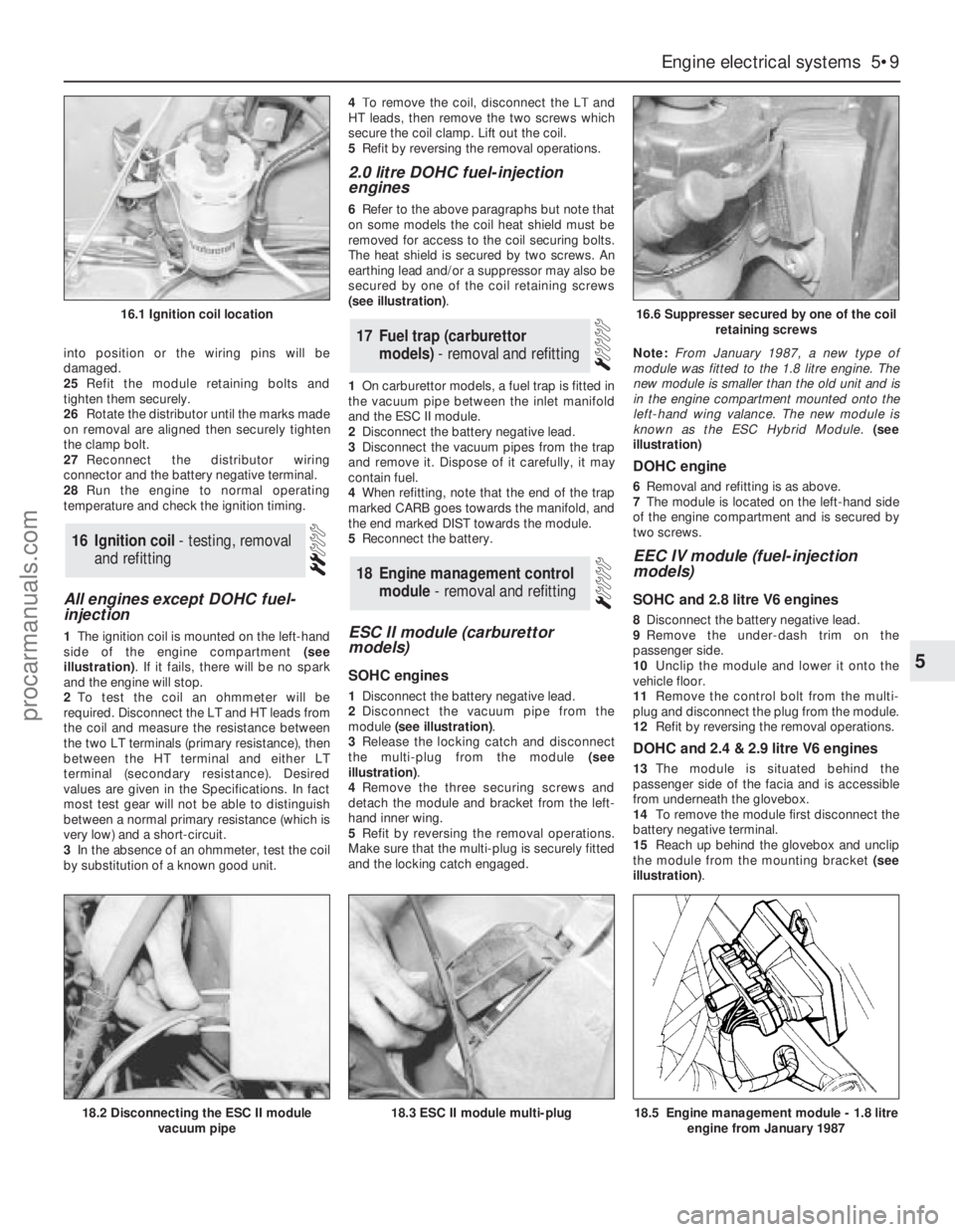
into position or the wiring pins will be
damaged.
25Refit the module retaining bolts and
tighten them securely.
26Rotate the distributor until the marks made
on removal are aligned then securely tighten
the clamp bolt.
27Reconnect the distributor wiring
connector and the battery negative terminal.
28Run the engine to normal operating
temperature and check the ignition timing.
All engines except DOHC fuel-
injection
1The ignition coil is mounted on the left-hand
side of the engine compartment (see
illustration). If it fails, there will be no spark
and the engine will stop.
2To test the coil an ohmmeter will be
required. Disconnect the LT and HT leads from
the coil and measure the resistance between
the two LT terminals (primary resistance), then
between the HT terminal and either LT
terminal (secondary resistance). Desired
values are given in the Specifications. In fact
most test gear will not be able to distinguish
between a normal primary resistance (which is
very low) and a short-circuit.
3In the absence of an ohmmeter, test the coil
by substitution of a known good unit.4To remove the coil, disconnect the LT and
HT leads, then remove the two screws which
secure the coil clamp. Lift out the coil.
5Refit by reversing the removal operations.
2.0 litre DOHC fuel-injection
engines
6Refer to the above paragraphs but note that
on some models the coil heat shield must be
removed for access to the coil securing bolts.
The heat shield is secured by two screws. An
earthing lead and/or a suppressor may also be
secured by one of the coil retaining screws
(see illustration).
1On carburettor models, a fuel trap is fitted in
the vacuum pipe between the inlet manifold
and the ESC II module.
2Disconnect the battery negative lead.
3Disconnect the vacuum pipes from the trap
and remove it. Dispose of it carefully, it may
contain fuel.
4When refitting, note that the end of the trap
marked CARB goes towards the manifold, and
the end marked DIST towards the module.
5Reconnect the battery.
ESC II module (carburettor
models)
SOHC engines
1Disconnect the battery negative lead.
2Disconnect the vacuum pipe from the
module (see illustration).
3Release the locking catch and disconnect
the multi-plug from the module (see
illustration).
4Remove the three securing screws and
detach the module and bracket from the left-
hand inner wing.
5Refit by reversing the removal operations.
Make sure that the multi-plug is securely fitted
and the locking catch engaged.Note: From January 1987, a new type of
module was fitted to the 1.8 litre engine. The
new module is smaller than the old unit and is
in the engine compartment mounted onto the
left-hand wing valance. The new module is
known as the ESC Hybrid Module.(see
illustration)
DOHC engine
6Removal and refitting is as above.
7The module is located on the left-hand side
of the engine compartment and is secured by
two screws.
EEC IV module (fuel-injection
models)
SOHC and 2.8 litre V6 engines
8Disconnect the battery negative lead.
9Remove the under-dash trim on the
passenger side.
10Unclip the module and lower it onto the
vehicle floor.
11Remove the control bolt from the multi-
plug and disconnect the plug from the module.
12Refit by reversing the removal operations.
DOHC and 2.4 & 2.9 litre V6 engines
13The module is situated behind the
passenger side of the facia and is accessible
from underneath the glovebox.
14To remove the module first disconnect the
battery negative terminal.
15Reach up behind the glovebox and unclip
the module from the mounting bracket (see
illustration).
18Engine management control
module - removal and refitting
17Fuel trap (carburettor
models) - removal and refitting
16Ignition coil - testing, removal
and refitting
Engine electrical systems 5•9
5
16.1 Ignition coil location16.6 Suppresser secured by one of the coil
retaining screws
18.2 Disconnecting the ESC II module
vacuum pipe18.5 Engine management module - 1.8 litre
engine from January 198718.3 ESC II module multi-plug
procarmanuals.com
Page 127 of 255
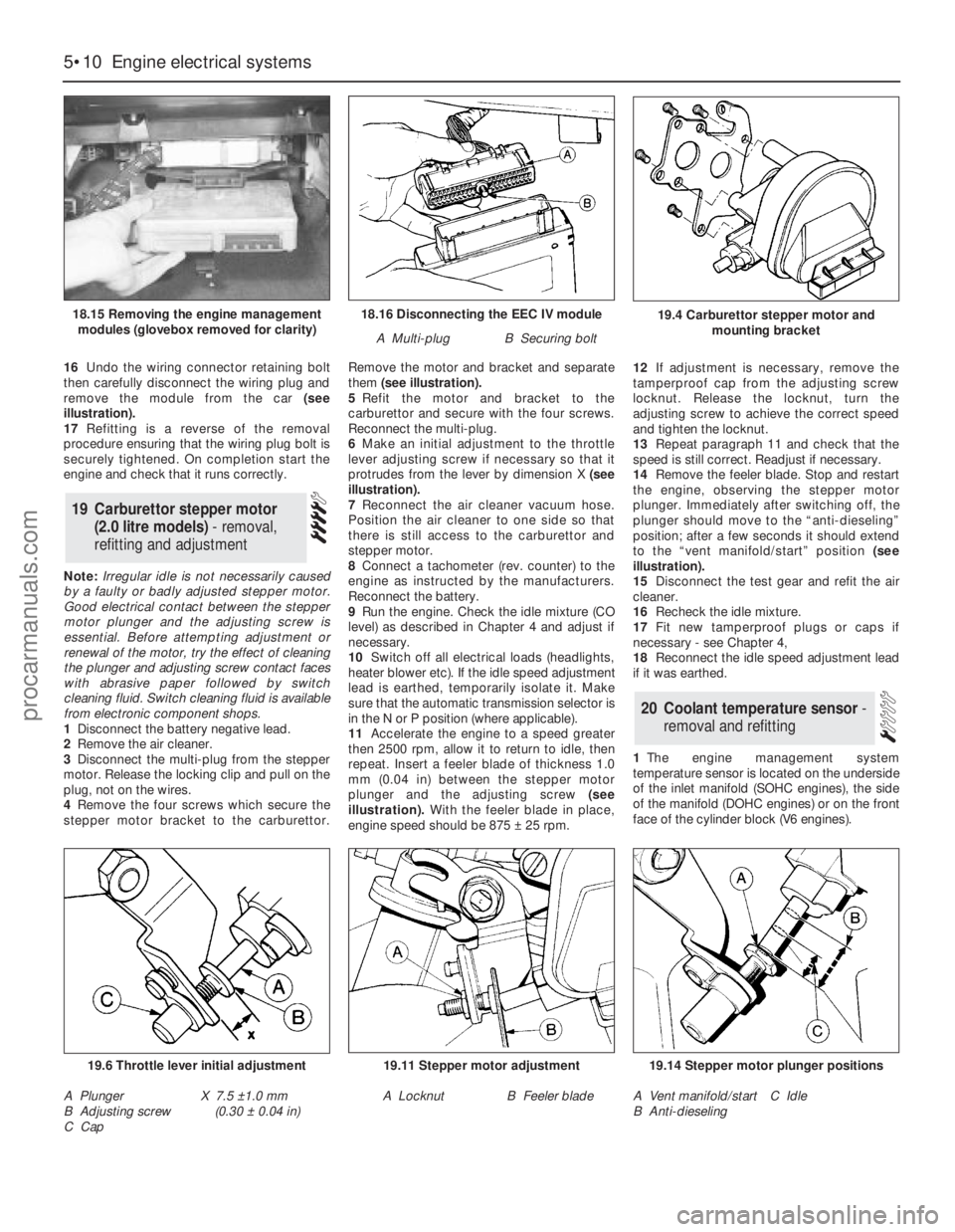
16Undo the wiring connector retaining bolt
then carefully disconnect the wiring plug and
remove the module from the car (see
illustration).
17Refitting is a reverse of the removal
procedure ensuring that the wiring plug bolt is
securely tightened. On completion start the
engine and check that it runs correctly.
Note: Irregular idle is not necessarily caused
by a faulty or badly adjusted stepper motor.
Good electrical contact between the stepper
motor plunger and the adjusting screw is
essential. Before attempting adjustment or
renewal of the motor, try the effect of cleaning
the plunger and adjusting screw contact faces
with abrasive paper followed by switch
cleaning fluid. Switch cleaning fluid is available
from electronic component shops.
1Disconnect the battery negative lead.
2Remove the air cleaner.
3Disconnect the multi-plug from the stepper
motor. Release the locking clip and pull on the
plug, not on the wires.
4Remove the four screws which secure the
stepper motor bracket to the carburettor.Remove the motor and bracket and separate
them (see illustration).
5Refit the motor and bracket to the
carburettor and secure with the four screws.
Reconnect the multi-plug.
6Make an initial adjustment to the throttle
lever adjusting screw if necessary so that it
protrudes from the lever by dimension X (see
illustration).
7Reconnect the air cleaner vacuum hose.
Position the air cleaner to one side so that
there is still access to the carburettor and
stepper motor.
8Connect a tachometer (rev. counter) to the
engine as instructed by the manufacturers.
Reconnect the battery.
9Run the engine. Check the idle mixture (CO
level) as described in Chapter 4 and adjust if
necessary.
10Switch off all electrical loads (headlights,
heater blower etc). If the idle speed adjustment
lead is earthed, temporarily isolate it. Make
sure that the automatic transmission selector is
in the N or P position (where applicable).
11Accelerate the engine to a speed greater
then 2500 rpm, allow it to return to idle, then
repeat. Insert a feeler blade of thickness 1.0
mm (0.04 in) between the stepper motor
plunger and the adjusting screw(see
illustration).With the feeler blade in place,
engine speed should be 875 ±25 rpm. 12If adjustment is necessary, remove the
tamperproof cap from the adjusting screw
locknut. Release the locknut, turn the
adjusting screw to achieve the correct speed
and tighten the locknut.
13Repeat paragraph 11 and check that the
speed is still correct. Readjust if necessary.
14Remove the feeler blade. Stop and restart
the engine, observing the stepper motor
plunger. Immediately after switching off, the
plunger should move to the “anti-dieseling”
position; after a few seconds it should extend
to the “vent manifold/start” position (see
illustration).
15Disconnect the test gear and refit the air
cleaner.
16Recheck the idle mixture.
17Fit new tamperproof plugs or caps if
necessary - see Chapter 4,
18Reconnect the idle speed adjustment lead
if it was earthed.
1The engine management system
temperature sensor is located on the underside
of the inlet manifold (SOHC engines), the side
of the manifold (DOHC engines) or on the front
face of the cylinder block (V6 engines).
20Coolant temperature sensor -
removal and refitting
19Carburettor stepper motor
(2.0 litre models) - removal,
refitting and adjustment
5•10Engine electrical systems
18.16 Disconnecting the EEC IV module
A Multi-plugB Securing bolt
19.6 Throttle lever initial adjustment
A Plunger
B Adjusting screw
C CapX 7.5 ±1.0 mm
(0.30 ±0.04 in)
19.11 Stepper motor adjustment
A LocknutB Feeler blade
19.14 Stepper motor plunger positions
A Vent manifold/start
B Anti-dieselingC Idle
19.4 Carburettor stepper motor and
mounting bracket18.15 Removing the engine management
modules (glovebox removed for clarity)
procarmanuals.com